-
 Bitcoin
Bitcoin $99,594.2189
-3.59% -
 Ethereum
Ethereum $2,188.5793
-9.00% -
 Tether USDt
Tether USDt $1.0001
-0.02% -
 XRP
XRP $1.9745
-5.82% -
 BNB
BNB $608.9511
-3.73% -
 Solana
Solana $130.4575
-5.93% -
 USDC
USDC $1.0000
0.01% -
 TRON
TRON $0.2637
-3.59% -
 Dogecoin
Dogecoin $0.1493
-5.97% -
 Cardano
Cardano $0.5322
-6.72% -
 Hyperliquid
Hyperliquid $33.9044
3.33% -
 Bitcoin Cash
Bitcoin Cash $449.6411
-5.46% -
 UNUS SED LEO
UNUS SED LEO $8.9629
0.43% -
 Sui
Sui $2.3943
-8.35% -
 Chainlink
Chainlink $11.4402
-7.83% -
 Stellar
Stellar $0.2241
-6.49% -
 Avalanche
Avalanche $16.1489
-4.24% -
 Toncoin
Toncoin $2.7182
-5.94% -
 Shiba Inu
Shiba Inu $0.0...01040
-5.72% -
 Litecoin
Litecoin $78.7882
-4.07% -
 Ethena USDe
Ethena USDe $1.0004
-0.01% -
 Hedera
Hedera $0.1305
-7.45% -
 Monero
Monero $297.0030
-5.32% -
 Dai
Dai $0.9997
-0.02% -
 Polkadot
Polkadot $3.1834
-6.03% -
 Bitget Token
Bitget Token $3.9788
-7.03% -
 Uniswap
Uniswap $6.1327
-10.62% -
 Pepe
Pepe $0.0...08689
-8.30% -
 Pi
Pi $0.4826
-9.65% -
 Aave
Aave $219.8043
-9.69%
Is VWAP useful near the daily limit? How to refer to the order volume?
VWAP remains useful near daily limits, helping traders spot overbought or oversold conditions by comparing current prices to the day's average trading price.
May 24, 2025 at 09:07 am
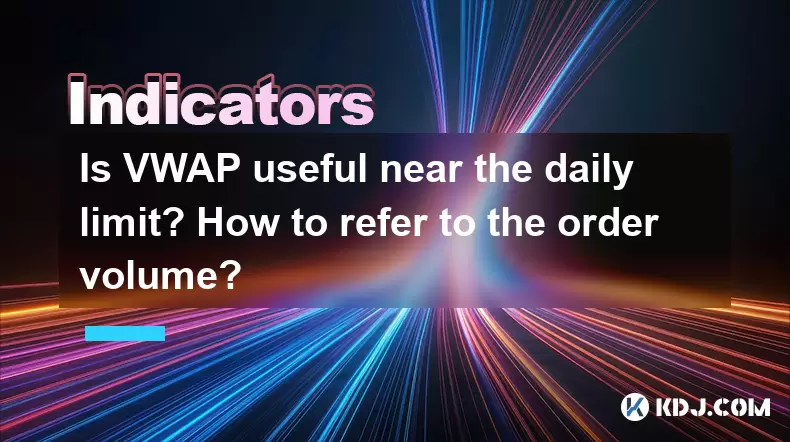
Understanding VWAP and Its Utility Near the Daily Limit
Volume Weighted Average Price (VWAP) is a key technical indicator used by traders in the cryptocurrency market to assess the average price at which a cryptocurrency has traded throughout the day, weighted by volume. It is particularly useful for traders looking to execute large orders without significantly impacting the market price. The question arises: Is VWAP still useful when a cryptocurrency is trading near its daily limit?
When a cryptocurrency approaches its daily limit, whether it is a price ceiling or floor set by the exchange, the dynamics of trading can change significantly. The VWAP can still be a valuable tool in these scenarios, but its utility might be somewhat altered. The VWAP can help traders understand the average price at which the asset has been trading, which can be crucial for making informed decisions about entry and exit points, even near the daily limit.
How VWAP Functions Near the Daily Limit
Near the daily limit, trading volumes might either surge or plummet depending on market sentiment. If the price is nearing the upper limit, traders might rush to buy, causing a spike in volume. Conversely, if the price is close to the lower limit, there might be a rush to sell, leading to increased selling pressure. In such scenarios, VWAP can help traders gauge whether the current price is above or below the average price for the day, which can be a signal for potential overbought or oversold conditions.
For example, if the price is trading near the upper daily limit and is significantly above the VWAP, it might indicate that the asset is overbought. Traders might then consider this as a signal to take profits or prepare for a potential price correction. On the other hand, if the price is near the lower daily limit and is significantly below the VWAP, it might suggest that the asset is oversold, prompting traders to look for buying opportunities.
Referring to Order Volume When Using VWAP
Order volume is a critical component when calculating and interpreting VWAP. The VWAP formula is designed to give more weight to price levels where higher volumes of trades have occurred. When referring to order volume in the context of VWAP, traders need to understand how to interpret and use this data effectively.
To calculate VWAP, traders need to have access to the price and volume data for each trade throughout the day. This data can usually be obtained from trading platforms or financial data providers. The formula for VWAP is as follows:
[ \text{VWAP} = \frac{\sum (\text{Price} \times \text{Volume})}{\sum \text{Volume}} ]
When referring to order volume, traders should focus on the following aspects:
- Total Volume Traded: This is the cumulative volume of all trades executed during the trading period.
- Volume at Specific Price Levels: This helps in understanding at which prices the majority of the trading volume has occurred.
- Volume Trends: Observing how volume changes over time can provide insights into market sentiment and potential price movements.
Practical Application of VWAP Near the Daily Limit
To apply VWAP effectively near the daily limit, traders need to combine it with other technical indicators and market analysis tools. For instance, using Moving Averages (MA) in conjunction with VWAP can provide a more comprehensive view of the market. If the price is near the upper daily limit and the VWAP is below both the short-term and long-term MAs, it might reinforce the signal that the asset is overbought.
Another practical application is using VWAP as a benchmark for setting stop-loss and take-profit orders. For example, if a trader enters a long position near the lower daily limit and the price is below the VWAP, they might set a take-profit order near the VWAP level, anticipating that the price will revert to the mean. Conversely, if entering a short position near the upper daily limit and the price is above the VWAP, a stop-loss might be set near the VWAP to limit potential losses if the price continues to rise.
Detailed Steps to Use VWAP in Trading
To effectively use VWAP in trading, especially near the daily limit, follow these steps:
- Access Real-Time Data: Ensure you have access to real-time price and volume data from a reliable source.
- Calculate VWAP: Use the VWAP formula to compute the indicator for the current trading session.
- Analyze the Current Price Relative to VWAP: Determine if the current price is above or below the VWAP and by how much.
- Combine with Other Indicators: Use other technical indicators like MAs, RSI, or MACD to confirm signals provided by VWAP.
- Set Trading Orders: Based on your analysis, set appropriate stop-loss and take-profit orders.
- Monitor Volume Trends: Keep an eye on volume trends to gauge market sentiment and potential price movements.
Interpreting VWAP Signals Near the Daily Limit
Interpreting VWAP signals near the daily limit requires a nuanced understanding of market dynamics. If the price is significantly above the VWAP and nearing the upper daily limit, it might indicate a strong bullish sentiment, but also a potential for a price correction. Traders might then consider taking profits or preparing for a short position if other indicators confirm the overbought condition.
Conversely, if the price is significantly below the VWAP and nearing the lower daily limit, it might suggest a strong bearish sentiment, but also a potential for a price rebound. Traders might then look for buying opportunities or consider closing short positions if other indicators suggest an oversold condition.
It's important to remember that while VWAP is a powerful tool, it should not be used in isolation. Combining it with other forms of analysis and risk management strategies can help traders make more informed decisions, especially in volatile market conditions near the daily limit.
Frequently Asked Questions
Q: Can VWAP be used for intraday trading as well as near the daily limit?
A: Yes, VWAP is highly versatile and can be used effectively for intraday trading. It helps traders gauge the average price at which the asset has been trading throughout the day, which can be useful for making entry and exit decisions. When used near the daily limit, it provides additional context about the asset's price relative to its average trading price, which can be crucial for strategic trading decisions.
Q: How does VWAP differ from other technical indicators like Moving Averages?
A: VWAP differs from Moving Averages primarily in its calculation and purpose. While Moving Averages provide a simple average of prices over a specific period, VWAP incorporates volume into its calculation, giving more weight to price levels with higher trading volumes. This makes VWAP particularly useful for understanding the true market price and for traders executing large orders.
Q: Is VWAP more effective on certain types of cryptocurrencies?
A: VWAP can be effective across various types of cryptocurrencies, but its utility might vary depending on the liquidity and trading volume of the asset. For highly liquid cryptocurrencies with large trading volumes, VWAP can provide more accurate and reliable signals. For less liquid cryptocurrencies, the effectiveness of VWAP might be reduced due to lower trading volumes and potential price manipulation.
Q: Can VWAP be used to predict price movements near the daily limit?
A: While VWAP itself is not a predictive tool, it can provide valuable insights into potential price movements near the daily limit. By comparing the current price to the VWAP, traders can identify overbought or oversold conditions, which might precede a price correction or rebound. However, for more accurate predictions, VWAP should be used in conjunction with other technical indicators and market analysis tools.
Disclaimer:info@kdj.com
The information provided is not trading advice. kdj.com does not assume any responsibility for any investments made based on the information provided in this article. Cryptocurrencies are highly volatile and it is highly recommended that you invest with caution after thorough research!
If you believe that the content used on this website infringes your copyright, please contact us immediately (info@kdj.com) and we will delete it promptly.
- Altcoins Under Pressure: Cardano and XRP Face Critical Tests
- 2025-06-23 12:25:12
- Rare Coin Fever in Wiltshire: Auctions, Errors, and Olympic Gold!
- 2025-06-23 12:25:12
- XRP Price Under Pressure: War Fears and Market Sentiment
- 2025-06-23 12:30:12
- HAI Token Private Key Leak: What Happened and How to Stay Safe
- 2025-06-23 12:45:12
- Texas Goes All In: Bitcoin Reserve Signals Big State Embrace
- 2025-06-23 12:45:12
- Pi Network's Price Plunge: Crash, Scammer Accusations, and What's Next?
- 2025-06-23 13:05:12
Related knowledge
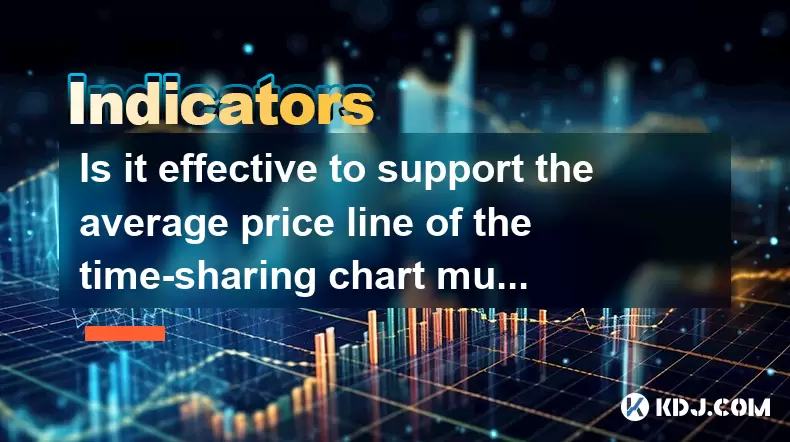
Is it effective to support the average price line of the time-sharing chart multiple times?
Jun 23,2025 at 01:36pm
Understanding the Average Price Line in Time-Sharing ChartsIn cryptocurrency trading, time-sharing charts refer to real-time price charts that display price movements over short intervals, often within a single trading day. Within these charts, the average price line, also known as the Volume Weighted Average Price (VWAP), is a commonly used technical i...
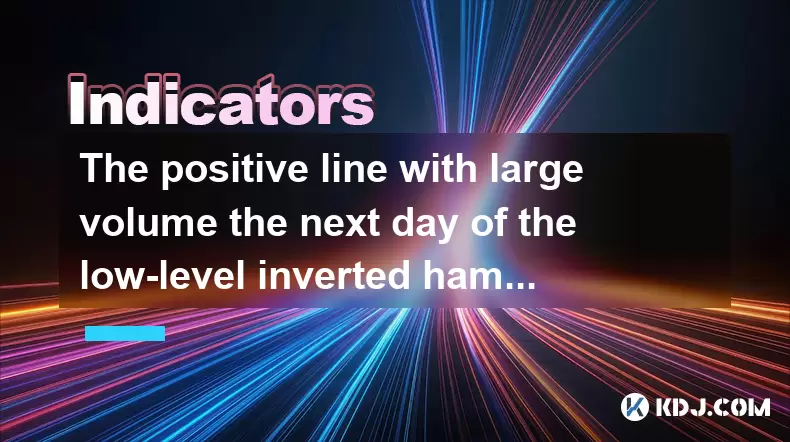
The positive line with large volume the next day of the low-level inverted hammer line confirms the reversal?
Jun 23,2025 at 01:21pm
Understanding the Low-Level Inverted Hammer LineThe inverted hammer line is a single candlestick pattern that typically appears at the end of a downtrend. It has a small real body near the bottom of the trading range and a long upper shadow, indicating that bulls attempted to push prices higher but were met with selling pressure. When this pattern forms...
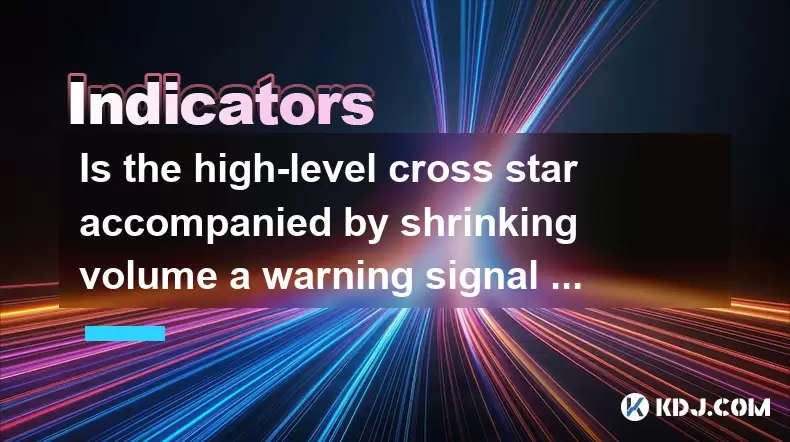
Is the high-level cross star accompanied by shrinking volume a warning signal of peaking?
Jun 23,2025 at 01:28pm
Understanding High-Level Cross Star PatternsIn the world of cryptocurrency trading, candlestick patterns are essential tools for technical analysis. One such pattern is the high-level cross star, which appears as a doji or near-doji candle at a significant resistance level. This pattern often indicates indecision in the market and can be interpreted as ...
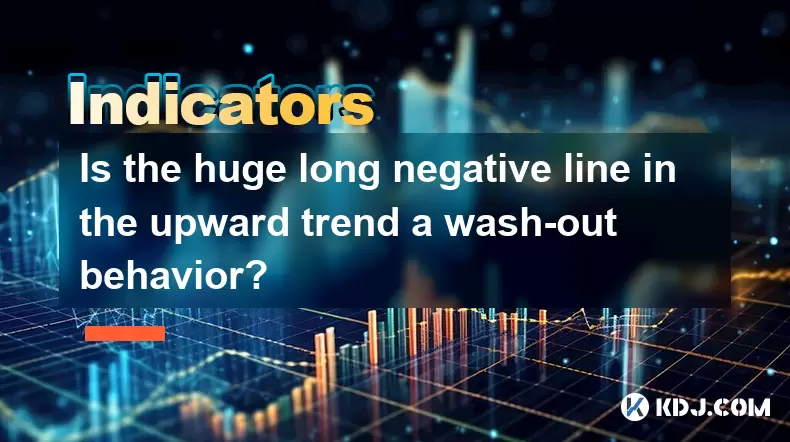
Is the huge long negative line in the upward trend a wash-out behavior?
Jun 23,2025 at 12:49pm
Understanding the Long Negative Candlestick in an Uprising TrendA long negative candlestick, often referred to as a long red or bearish candle, appearing during an upward trend can raise concerns among traders and investors. This pattern typically indicates a sudden and significant drop in price after a period of rising prices. It is often interpreted a...

Can the EXPMA golden cross stand on the 5-day line at the same time?
Jun 23,2025 at 11:42am
Understanding the EXPMA Indicator in Cryptocurrency TradingThe Exponential Moving Average (EXPMA) is a popular technical analysis tool used by cryptocurrency traders to identify trends and potential reversal points. Unlike simple moving averages, the EXPMA gives more weight to recent price data, making it more responsive to current market conditions. In...

Does the second surge in the RSI overbought zone induce more?
Jun 22,2025 at 08:35am
Understanding the RSI Overbought ZoneThe Relative Strength Index (RSI) is a momentum oscillator commonly used in technical analysis to measure the speed and change of price movements. It ranges from 0 to 100, with values above 70 typically considered overbought and values below 30 considered oversold. When the RSI enters the overbought zone for the firs...

Is it effective to support the average price line of the time-sharing chart multiple times?
Jun 23,2025 at 01:36pm
Understanding the Average Price Line in Time-Sharing ChartsIn cryptocurrency trading, time-sharing charts refer to real-time price charts that display price movements over short intervals, often within a single trading day. Within these charts, the average price line, also known as the Volume Weighted Average Price (VWAP), is a commonly used technical i...

The positive line with large volume the next day of the low-level inverted hammer line confirms the reversal?
Jun 23,2025 at 01:21pm
Understanding the Low-Level Inverted Hammer LineThe inverted hammer line is a single candlestick pattern that typically appears at the end of a downtrend. It has a small real body near the bottom of the trading range and a long upper shadow, indicating that bulls attempted to push prices higher but were met with selling pressure. When this pattern forms...

Is the high-level cross star accompanied by shrinking volume a warning signal of peaking?
Jun 23,2025 at 01:28pm
Understanding High-Level Cross Star PatternsIn the world of cryptocurrency trading, candlestick patterns are essential tools for technical analysis. One such pattern is the high-level cross star, which appears as a doji or near-doji candle at a significant resistance level. This pattern often indicates indecision in the market and can be interpreted as ...

Is the huge long negative line in the upward trend a wash-out behavior?
Jun 23,2025 at 12:49pm
Understanding the Long Negative Candlestick in an Uprising TrendA long negative candlestick, often referred to as a long red or bearish candle, appearing during an upward trend can raise concerns among traders and investors. This pattern typically indicates a sudden and significant drop in price after a period of rising prices. It is often interpreted a...

Can the EXPMA golden cross stand on the 5-day line at the same time?
Jun 23,2025 at 11:42am
Understanding the EXPMA Indicator in Cryptocurrency TradingThe Exponential Moving Average (EXPMA) is a popular technical analysis tool used by cryptocurrency traders to identify trends and potential reversal points. Unlike simple moving averages, the EXPMA gives more weight to recent price data, making it more responsive to current market conditions. In...

Does the second surge in the RSI overbought zone induce more?
Jun 22,2025 at 08:35am
Understanding the RSI Overbought ZoneThe Relative Strength Index (RSI) is a momentum oscillator commonly used in technical analysis to measure the speed and change of price movements. It ranges from 0 to 100, with values above 70 typically considered overbought and values below 30 considered oversold. When the RSI enters the overbought zone for the firs...
See all articles

























































































